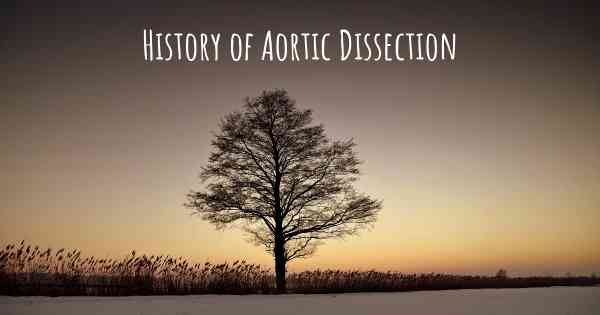What is the history of Aortic Dissection?
When was Aortic Dissection discovered? What is the story of this discovery? Was it coincidence or not?

Aortic Dissection: A Historical Perspective
Aortic dissection is a life-threatening medical condition characterized by a tear in the inner layer of the aorta, the largest artery in the human body. This tear allows blood to flow between the layers of the aortic wall, potentially leading to aortic rupture, organ damage, and even death. The history of aortic dissection dates back several centuries, with significant advancements in understanding, diagnosis, and treatment.
Early Observations and Recognition
The first documented case of aortic dissection can be traced back to the 18th century. In 1761, the renowned Scottish physician William Hunter described a case of sudden death in a young woman, attributing it to a rupture in the aorta. However, it was not until the early 19th century that aortic dissection gained more recognition as a distinct clinical entity.
Recognition of Aortic Dissection as a Separate Condition
In 1812, the French physician René Laennec, known as the father of modern auscultation, described aortic dissection as a separate condition from aneurysm. He emphasized the importance of distinguishing between the two, as the treatment approaches differed significantly. Laennec's work laid the foundation for further research and understanding of aortic dissection.
Advancements in Diagnosis
Throughout the 19th and early 20th centuries, medical practitioners made significant progress in diagnosing aortic dissection. In the late 19th century, the German physician Friedrich Daniel von Recklinghausen introduced the concept of "dissecting aneurysm" and proposed a classification system based on the location of the dissection. This classification system provided a framework for understanding the different types of aortic dissection.
Emergence of Imaging Techniques
The development of imaging techniques in the 20th century revolutionized the diagnosis and management of aortic dissection. In the 1950s, the advent of contrast-enhanced angiography allowed for direct visualization of the aorta and its branches, enabling more accurate diagnosis of aortic dissection. However, angiography was an invasive procedure with associated risks.
Computed Tomography (CT) and Magnetic Resonance Imaging (MRI)
In the 1970s, the introduction of computed tomography (CT) and magnetic resonance imaging (MRI) provided non-invasive alternatives for diagnosing aortic dissection. CT scans allowed for detailed imaging of the aorta, while MRI provided excellent soft tissue visualization. These imaging modalities became essential tools in the diagnosis and management of aortic dissection.
Advancements in Surgical Treatment
The surgical management of aortic dissection has also evolved significantly over time. In the early 20th century, surgical intervention for aortic dissection was rare and associated with high mortality rates. However, with advancements in surgical techniques and perioperative care, the outcomes improved.
Thoracic Aortic Stent Grafts
In the late 20th century, the development of thoracic aortic stent grafts revolutionized the treatment of aortic dissection. These endovascular devices could be inserted through minimally invasive procedures, reducing the risks associated with open surgery. Thoracic aortic stent grafts provided a less invasive alternative for patients with aortic dissection, particularly those who were not suitable candidates for open surgery.
Current Research and Future Directions
Research in the field of aortic dissection continues to advance our understanding of the condition and improve treatment outcomes. Ongoing studies focus on identifying genetic predispositions, refining diagnostic techniques, and exploring novel therapeutic approaches. The goal is to further enhance early detection, optimize treatment strategies, and ultimately improve patient survival rates.
In conclusion, the history of aortic dissection spans several centuries, with significant advancements in recognition, diagnosis, and treatment. From early observations and differentiation from aneurysms to the emergence of imaging techniques and minimally invasive interventions, the understanding and management of aortic dissection have come a long way. Ongoing research and technological advancements hold promise for further improving outcomes and saving lives.
Surgery for aortic dissection was first introduced and developed by Michael E. DeBakey, Denton Cooley, and Oscar Creech, cardiac surgeons associated with the Baylor College of Medicine, Houston, Texas, in 1954. DeBakey developed aortic dissection himself at age 97 in 2005,[3] and underwent surgery in 2006.[23] Endovascular treatment of aortic dissection was developed in the 1990s.[3]
Source: https://en.wikipedia.org/wiki/Aortic_dissection
Posted Sep 11, 2017 by Timo Söderlund 6072
there have been many famous cases since with many illustrious names such as deBakey making medical history.
many famous and not so famous people have been taken from us due to Aortic Dissection, none I believe to be more important than any other.
We are all equal.
Posted Sep 11, 2017 by Dan 1998
2 generations ago People died of Aortic disease period they had no idea why or what cause it , you didn't know what it was when it happened... and it wasn't Until very recently with Ultrasound , sonigrams and later MRI & CT 's that allow them to be seen...did anyone catch on ... if it was found during Open heart surgery they would attempt repairs which is impossible to do , like replacing a auto Radiator hose with the car Running (your gonna get wet) until Dr Michael Debakey, a former Army surgeon in practice in Texas used a Heart Lung Bypass machine to be able to actually stop the heart and allow the Blood to pump through the machine instead of the heart.... With time, Debakey expanded the group of Knowledge and experience with others also getting involved , increasing positive outcomes manyfold by cooling the blood and body well below normal human temperature which has been found to improve the brain cell function following surgery, Feel free to search Post Perfusion Syndrome
Posted Sep 22, 2017 by Jim 5641
Posted Feb 3, 2018 by Lindsay McKinney 2520
The earliest fully documented case of aortic dissection is attributed to Frank Nicholls in his autopsy report of King George II of Great Britain, who had been found dead on 25 October 1760; the report describes dissection of the aortic arch and into the pericardium.[3][29] The term "aortic dissection" was introduced by the French physician J.P. Maunoir in 1802, and René Laennec labelled the condition "dissecting aneurysm".[3][30] London cardiologist Thomas Bevill Peacock contributed to the understanding of the condition by publishing two series of the cases described in the literature so far: 19 cases in an 1843 review, and 80 in 1863.[30] The characteristic symptom of tearing pain in the chest was recognized in 1855 when a case was diagnosed in life.[30]
Posted Sep 23, 2018 by Stefan 2500
Posted Mar 12, 2019 by Bengt 2500
Posted Oct 9, 2019 by Sandy 2500
Posted May 28, 2020 by Arne 2300
Posted Apr 4, 2021 by Robert 9039
Posted Apr 2, 2022 by Larry 2550








